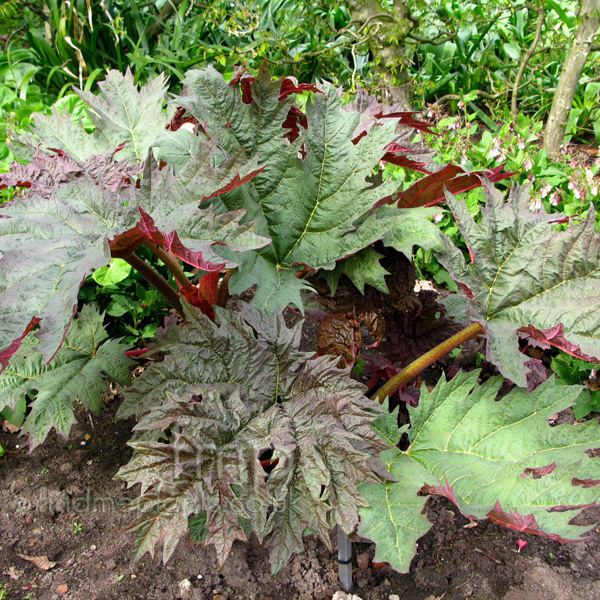Scientific name Rheum Rank Genus | ||
 | ||
Lower classifications | ||
Rheum is a genus of about 60 perennial plants in the family Polygonaceae. The genus includes the vegetable rhubarb (Rheum rhabarbarum or Rheum x hybridum.) The species have large somewhat triangular shaped leaves with long, fleshy petioles. The flowers are small, greenish-white to rose-red, and grouped in large compound leafy inflorescences. A number of varieties of rhubarb have been domesticated both as medicinal plants and for human consumption. While the leaves are toxic, the stalks are used in pies and other foods for their tart flavor.
Contents

Description
Rheum species are herbaceous perennials growing from fleshy roots. They have upright growing stems and mostly basal, deciduous leaves growing from short, thick rhizomes. They have persistent or deciduous ocrea. The inflorescences are terminal and panicle-like with pedicels. The hermaphrodite flowers consist of a whitish green to pinkish green, hairless and campanulate perianth, composed of six tepals. The outer three tepals are narrower than the inner three and all are sepal-like in appearance. The flowers have nine (sometimes six) stamina inserted on the torus at the base of the peranthium, they are free or subconnatent at their base. The anthers are yellow or pinkish green, elliptic in shape. The ovary is simple and triangular shaped with three erect or deflexed styles. The stigmas are head-like. The fruits are a three-sided achene with winged sides, and the seeds are albuminous with a straight or curved embryo.

The name has its origin in the Ancient Greek word rheon, which was used by Dioscorides, possibly for a plant in this genus.
Uses

Many rheum species have food and medicinal uses. Some of these uses originated in Asia more than 2,000 years ago. Rheum rhabarbarum is used to make pies, jellies, jams, and wine. All parts of the plant contain slightly poisonous oxalic acid, but its concentration in the leaf stems or petioles used in food preparation is very low, and their tart flavor instead is caused by nontoxic malic acid. The plants also produce other compounds, including citric acid and anthraquinone glycosides, and the raw or cooked leaf blades are poisonous to humans and livestock if consumed in large enough amounts. Plants in cultivation are propagated by cutting up the crowns of larger plants and by seeds.
Some species are grown for their ornamental qualities, including R. acuminatum, R. alexandrae, R. australe, R. kialense, R. palmatum, R. rhabarbarum and R. ribes.
Species
The genus is represented by about 60 extant species. Among species found in the wild, those most commonly used in cooking are the garden rhubarb (R. rhabarbarum) and the so-called false rhubarb (R. rhaponticum), which is actually a true rhubarb. The many varieties of cultivated rhubarb more usually grown for eating are recognised as Rheum x hybridum in the Royal Horticultural Society's list of recognised plant names. The drug rheum is prepared from the rhizomes and roots of another species, R. officinale or medicinal rhubarb. This species is also native to Asia, as is the turkey rhubarb (R. palmatum). Another species, the Sikkim rhubarb (R. nobile), is limited to the Himalayas.
Rheum species have been recorded as larval food plants for some Lepidoptera species including brown-tail, buff ermine, cabbage moth, large yellow underwing, and nutmeg moth.
Species within this genus include:
